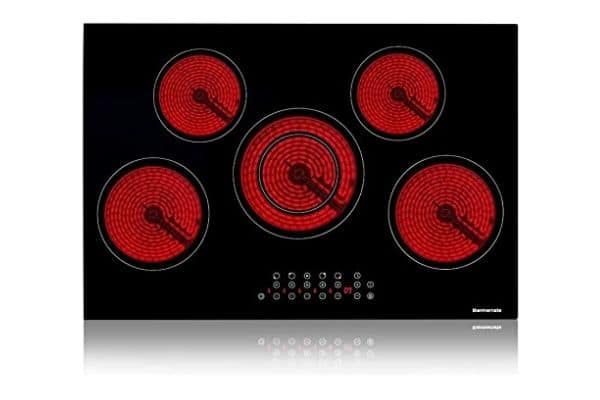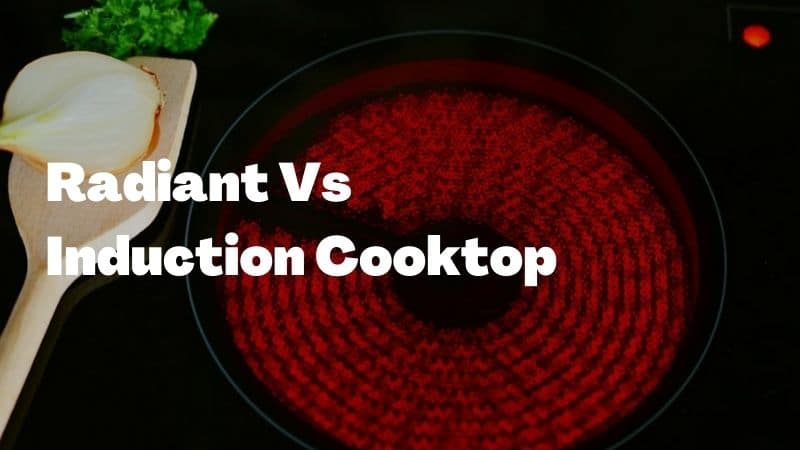When it comes to cooking, there are many different types of stoves and cooktops. One such type is the radiant vs induction cooktop. Which one should you choose? This blog post will explore the differences between these two types of cooktops and help you make a decision on which one is right for your needs!
What Is A Radiant Cooktop?
A radiant cooktop is basically an all-electric cooktop that consists of one or more heating elements that sit beneath a smooth glass cooking surface. This means that you can simply place pots and pans on the glass surface to heat them up. These are often referred to as ‘flat top’ cookers because they provide a flat-level surface for your pots and pans to sit on.

How Does A Radiant Cooker Work?
These types of electric cookers work by having one or more element which heats the pot sitting directly on the glass surface itself where it gets heated up; this means that no open flame is used like with gas or oil stoves, but also that you need to be extremely careful where you place your cooking equipment so that it does not crack or shatter the glass.
Radiant Cooktop Pros And Cons
Pros
- Generally cheaper than induction cooktops. Many users prefer to use radiant cooktops due to their lower price and ease of use for novice cooks and bachelors without much kitchen experience. While this may be true, an induction cooktop may still offer better performance benefits for experienced chefs willing to pay more money for better results.
- Uses less electricity than an induction cooktop and many other types of burners. This allows the stove to use a lower wattage and still cook foods normally, removing the need for excess power consumption.
- Easy to clean due to flat cooking surface. The entire cooking surface can be wiped down with a cloth or paper towel easily after each meal. This reduces the amount of time spent cleaning up after cooking which may lead to an increase in how often someone uses their stove top if they dislike cleaning it frequently while using other methods such as boiling water on a gas range or an electric oven.
Cons
- Does not work well on large, thick pots and pans. When using a much larger pot or pan than normal, it will take much longer to heat up the whole cooking surface of the pan, resulting in areas that are not hot enough to cook certain foods. It is best for smaller foods with even cooking power.
- If the food has sauces or liquids added to it, those parts of the food will heat up faster than hotter areas of the cooking surface which cooks more slowly. Some users have noted problems with these sections overcooking compared to other sections due to this effect. This can be solved by stirring before serving.
- Does not distribute heat evenly. Usually, the area directly around the heating element will be hotter than other sections of the cooking surface. This does not pose a huge problem if only using smaller pots and pans but can cause some foods to come out unevenly cooked compared to others in a larger pot or pan that covers more of the exposed heating element.
Radiant Cooktops Vs Induction Cooktops
Radiant cooktops are better for cooking over low heat, while induction cooktops are great for boiling water faster. If you are looking to save money on your energy bills, then an induction stove is the way to go because it uses less power than radiant stoves. If you have a very busy family or you love to cook, then inductions might be the way to go since it heats water so quickly. Additionally, if you have kids in the house who can’t seem to keep their little hands away from the burners, then induction will give them less opportunities to get burned.
Both types of stove tops offer clean lines and elegant designs that will look great with any kitchen style. Many people like buying used radiant or induction stoves because they are very durable and will last for many years.
Induction stoves are usually more expensive than radiant stoves, but induction cooktops are typically much faster to boil water compared to radiant cooktops. Additionally, if you don’t have a lot of counter space in your kitchen then an induction unit may be the way to go since it’s smaller compared to radiant stove that use burners instead of electromagnetic fields.
Both types of stoves are very durable and will last for many years in most kitchens. Additionally, both offer high-quality cooking without hot spots or burnt edges so you can rest assured your meals will turn out just right every time. Both stoves are great at cooking food evenly so full meals can be prepared on them without having to worry about some pieces being cooked faster than others.
Radiant Cooktops Vs Electric Or Gas Ranges?
Radiant cooktops provide instant heat and adjust instantly to pan position, allowing for quick searing without having to use additional pans or wait for the surface of the burner to cool down between uses.
They also don’t require pre-heating like electric ranges do, and their smaller burners allow for more direct control over temperatures than gas ranges do. Since they work using infrared energy rather than flames and electricity, radiant cooktops offer many advantages over both traditional electric and gas ranges:
1) Instantaneous heating: unlike most other ranges, radiant cooktops are capable of providing nearly instant heat due to its use of infrared heating. This allows for quick searing and efficient cooking even with a small amount of food.
2) No pre-heating time: radiant cooktops don’t need to be preheated like electric ranges do, which means you don’t have to wait before starting to cook. This makes them more efficient than both electric and gas ranges in this regard.
3) More control over heat levels/increased temperature range: since the heat from these burners is generated directly on top of the pan itself rather than between burner flames or from electricity, they offer much greater control over the cooking temperature. Their smaller burners allow for a larger range of temperatures that can be chosen compared to traditional gas stoves as well, which only offer a single heat setting.
4) No hot-spots: radiant cooktops do not have the same “hot spots” that are found on electric or gas ranges, because the heat is generated directly onto the pan rather than through the burner chamber itself. This allows for more even cooking of food, regardless of where it’s placed on top of the burner.
5) More energy efficient: radiant cooktops use infrared energy to bring direct intense heat to pans, allowing them to transfer more intense heat faster without wasting any energy heating up unnecessary air around the pan. They are also capable of achieving higher temperatures in less time than electric or gas range burners, making them much better at bringing water to boil in an instant if needed.
6) Easy to clean: radiant cooktops are capable of providing immaculate one-touch cleaning, because cooking oils and liquids do not drip down the burner chamber walls after use. This is due to the fact that radiant cooktops only create heat on top of pans rather than between them, which means there is no risk of these materials spilling onto the cabinet below.
7) Unlike electric ranges, radiant cooktops are capable of withstanding low humidity levels without malfunctioning or experiencing lowered performance levels. Electric ranges require high amounts of ambient humidity in order to provide their best performance under most conditions, while radiant cooktops work effectively even when these conditions aren’t present.
8) Even heating for large pots/pans: unlike gas stoves, radiant cooktops provide even heating for large pots and pans due to the uniform way in which their heat is distributed. This allows them to be used effectively with large pans that would otherwise pose a challenge for electric or gas ranges.
9) More stable: another advantage of using infrared energy rather than flames and electricity for cooking is that radiant cooktops are inherently more stable than either electric or gas ranges because they do not pose such a high risk of burns from open flame. Since this type of range only heats the pan itself, it never poses a safety hazard no matter where you place your hands on top of it – in fact, you can rest a hand directly on top of a hot pan without suffering any injury at all!
10) Versatile: radiant cooktops are perfect for use with any type of pot or pan, whether they are non-stick, ceramic – even cast iron. They will work just as well on traditional stainless steel pots and pans as they do on specialized cookware like copper or aluminum utensils.
11) Radiant cooktops are capable of providing higher performance levels than electric ranges at lower prices, while still offering the exact same level of convenience without compromising power. They offer the same kind of control over cooking temperature that gas stoves provide but do not pose a fire hazard or require you to get down onto your hands and knees to light them up unlike their flame-powered counterparts!
Conclusion
If you’re not sure whether to buy a radiant or induction stove, then go with the one that offers more features and fits your style. If you need something small, lightweight and more affordable, then look at radiant stoves as they are usually less expensive. If you have a little extra money to spare and want a cooking appliance that creates more heat faster, then look at induction cooktops since they also boil water quickly.
